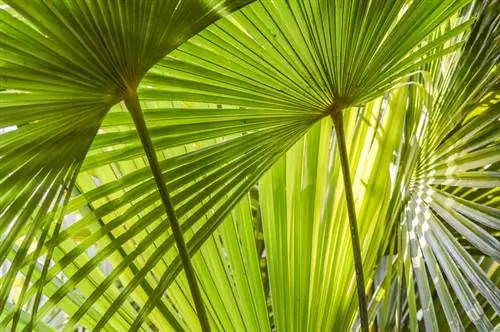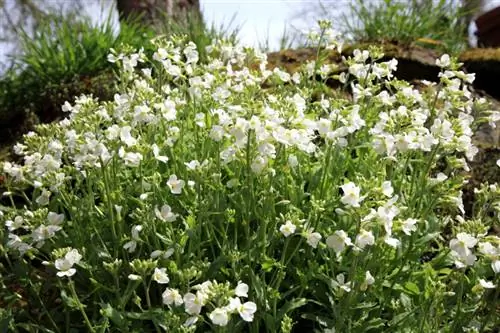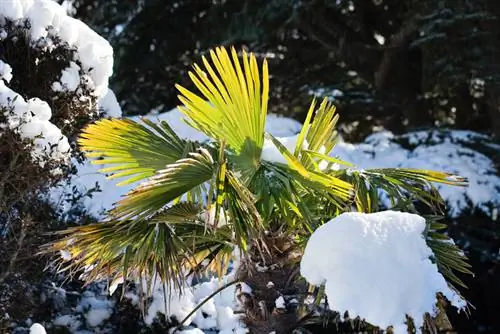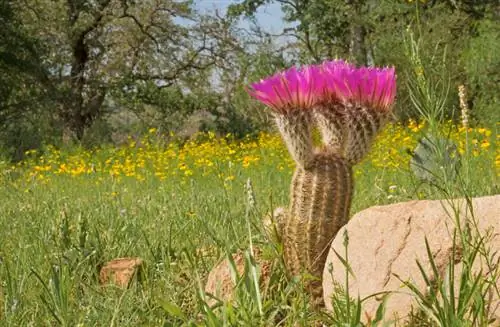- Author admin [email protected].
- Public 2023-12-16 16:46.
- Last modified 2025-01-23 11:20.
Dream under palm trees in your own garden - this wish becomes reality with frost-resistant varieties. There are a number of plants from the Arecales family that, with a little winter protection, can withstand even low temperatures. Since their requirements for location, wintering and temperature differ significantly, we would like to give you a brief overview of the palm species that thrive here in this article.

Which types of palm trees are hardy for the garden?
The hardy palm species include hemp palm (Trachycarpus fortunei), needle palm (Rhapidophyllum hystrix), honey palm (Jubaea chilensis), dwarf palm (Chamaerops humilis), dwarf palmetto palm (Sabal minor), Yunnan dwarf palm (Trachycarpus nanus) and petticoat palm (Washingtonia filifera). However, they usually need winter protection such as frost protection fleeces and root protection with mulch covers.
Which types are suitable?
Extremely robust and commonly found:
- Hemp palm (Trachycarpus fortunei)
- Needle palm (Rhapidophyllum hystrix)
- Honey palm (Jubaea chilensis)
- Dwarf palm (Chamaerops humilis)
- Dwarf palmetto palm (Sabal minor)
- Yunnan dwarf palm (Trachycarpus nanus)
- Petticoat palm (Washingtonia filifera)
Hemp palm (Trachycarpus fortunei)
It is probably the best known and most popular hardy palm tree. Since it grows very quickly compared to other varieties and is quite undemanding, this is hardly surprising. Its natural home is the moist, shady forest areas of China where it can be found at altitudes of up to 2,500 meters.
Appearance
These palms form a typical crest. The trunk is covered with brown fibers that fall off over the years. The leaves are strong and cut right down to the base of the leaf.
Winter hardiness
The hemp palm defies temperatures down to 20 degrees below zero. If you suffer any damage from the cold, this can be overcome as it has a high ability to regenerate. When the wind blows, the fronds bend slightly and then hang down at the tips. So give it a place protected from the wind.
Needle palm (Rhapidophyllum hystrix)
This umbrella palm forms runners and grows into a pretty group of palm trees over the years. Its homeland is the southeastern United States, where it can be found in damp places in the forests.
Appearance
The needle palm rarely grows higher than one meter in our latitudes. The trunk is covered in dark fibers from which countless sharp needles protrude. They gave the palm tree its German name. The leaves are cut almost to the base of the leaf and have a slightly silvery shimmer on the underside.
Winter hardiness
This palm's frost resistance is legendary. Once planted, it can even withstand temperatures of up to -25 degrees. Since it grows very slowly, larger specimens are expensive and rarely found in stores.
Honey palm (Jubaea chilensis)
This type of palm tree originally grows in the area of Santiago de Chile. From here it began its worldwide triumph and is now native to almost all countries with a Mediterranean climate.
Appearance
Typical of the honey palm is its gray, massive trunk with feathery leaves. It was even threatened with extinction for a short time because palm honey, palm wine and palm sugar are made from its sap. It only forms flowers and fruits, which are only three centimeters tall but look remarkably similar to coconuts.
Winter hardiness
When planted outdoors, the honey palm is frost-resistant down to around -12 degrees. In rougher locations it definitely needs adequate winter protection.
Dwarf palm (Chamaerops humilis)
The natural home of this palm is the Mediterranean region. It grows very slowly and only a few specimens reach great heights, which gave this pretty representative of its species the name dwarf palm.
Appearance
A plant usually forms several trunks that are very close together and are covered with brown fibers. The foliage is dark green, stiff and therefore relatively resilient. The petioles of the dwarf palm are thorny.
Winter hardiness
The robustness of this species is legendary. With a little winter protection, it can also survive longer cold periods with temperatures below -10 degrees. However, the roots are more sensitive than other palm species and must be protected from the cold with a polystyrene block underneath or an extra-thick layer of mulch.
Dwarf palmetto palm (Sabal minor)
This palm tree, which comes from North America, is one of the extremely hardy species. It can be propagated by seeds in spring and germinates a little faster than many other varieties.
Appearance
The trunk is smooth and gray, the large leaves are cut halfway. They are very dark with a slight gray cast. After withering, they fall off on their own.
Winter hardiness
The dwarf palmetto palm is one of the absolute frost artists. It can even handle frosts down to -20 degrees well.
Yunnan dwarf palm (Trachycarpus nanus)
This very small palm tree thrives in the Chinese province of Yunnan at altitudes of around 1,000 meters.
Appearance
This type of palm differs from many others visually in that it does not form an above-ground trunk and grows bushy. The fronds are deeply cut and have narrow, lancet-like leaflets.
Winter hardiness
This palm thrives excellently in the Central European climate. It is considered frost-resistant down to -18 degrees and does not require excessive winter protection even in harsh locations.
Petticoat palm (Washingtonia filifera)
In its natural home of Mexico, it reaches considerable heights of up to thirty meters. These palm trees owe their funny name to the fact that the dried, brown leaves hang down for a long time until they eventually fall off. This looks like the plant is wearing a full skirt.
Appearance
The trunk of the petticoat palm can reach considerable thickness. The leaves, which are cut in half, hang a little limply and there are numerous threads between the leaf segments. The stems are thorny.
Winter hardiness
This type of palm tree is extremely robust. It tolerates hot summer temperatures just as well as light frosts down to -10 degrees. In milder wine-growing regions it can be easily cultivated in the garden.
Tip
Even hardy palm trees need adequate winter protection. Frost protection fleeces (€23.00 on Amazon), in which the plant can be carefully tied, are well suited. Good root protection through a thick mulch of leaves and brushwood is also recommended.






